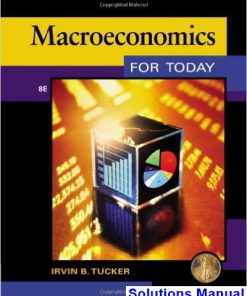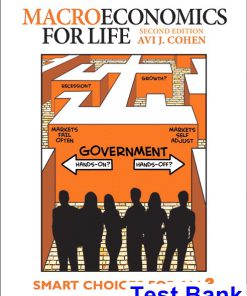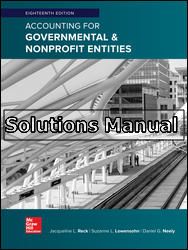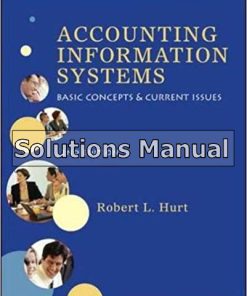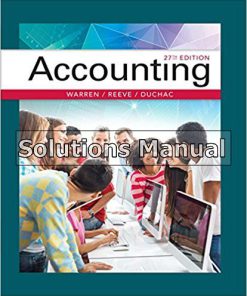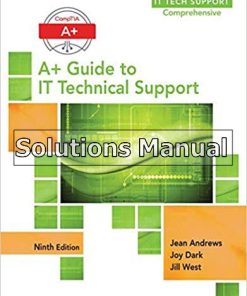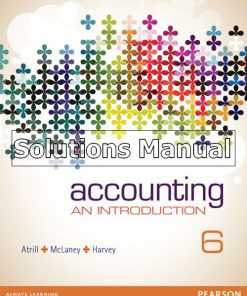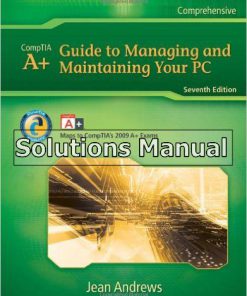Macroeconomics for Life Smart Choices for All Canadian 2nd Edition Cohen Solutions Manual
$50.00 Original price was: $50.00.$26.50Current price is: $26.50.
Macroeconomics for Life Smart Choices for All Canadian 2nd Edition Cohen Solutions Manual.
This is completed downloadable of Macroeconomics for Life Smart Choices for All Canadian 2nd Edition Cohen Solutions Manual
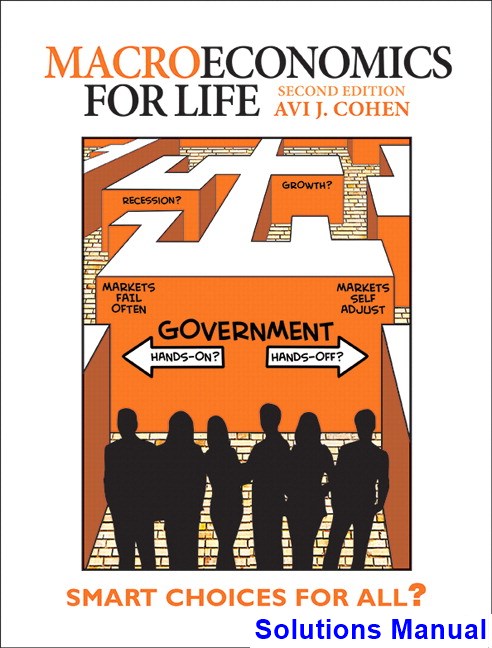
Product Details:
- ISBN-10 : 0133135845
- ISBN-13 : 978-0133135848
- Author: Avi J. Cohen
Micro/Macro Economics for Life 2e addresses the growing market needs and trends toward a literacy targeted approach to teaching economics, supported by an active-learning pedagogy and premium online teaching and learning resources.
Macroeconomics for Life offers a new narrative-driven approach to learning and teaching economics that demonstrates the relevance of economics to students. Accessible language and graphs, engaging first-person writing, a less-mathematical approach, and practical examples connect economics to students’ lives in a meaningful way. This text helps students become economically literate citizens, unlike traditional texts which prepare them to become economics majors.
Table of Content:
- 1 What’s in Economics for You? Scarcity, Opportunity Cost, Trade, and Models
- 1 What’s in Economics for You?
- Are You Getting Enough? Scarcity and Choice
- Refresh 1.1
- Give It Up for Opportunity Cost! Opportunity Cost
- Opportunity Cost Beats Money Cost
- Economics Out There: Where Have All the Men Gone?
- Incentives Work
- Refresh 1.2
- Why Don’t You Cook Breakfast? Gains from Trade
- Voluntary Trade
- Bake or Chop?
- Production Possibilities Frontier
- Deal or No Deal? Do the Numbers
- Comparative Advantage
- Smart Deals
- Achieving the Impossible
- Refresh 1.3
- Economists as Mapmakers and Scientists: Thinking Like an Economist
- Why Maps (and Economists) Are Useful
- The Circular Flow of Economic Life
- Economic Models
- Follow the Flow Clockwise
- Models as the Economist’s Laboratory
- All Other Things Unchanged
- Economics Out There: Do You Want to Be an Online Gamer Economist?
- Positive and Normative Statements
- Refresh 1.4
- Where and How to Look: Models for Microeconomics and Macroeconomics
- It’s All Greek to Me: Microeconomics or Macroeconomics?
- Macroeconomics
- Looking at the Trees or the Forest?
- Three Keys to Smart Choices: Weigh Marginal Benefits and Marginal Costs
- Key 1: Opportunity Costs Rule
- Key 2: Look Forward Only to Additional Benefits and Opportunity Costs
- Key 3: Implicit Costs and Externalities Count, Too
- Negative Externalities
- Positive Externalities
- Moving On
- Refresh 1.5
- Study Guide: Chapter 1 Summary
- 1.2 Give It Up for Opportunity Cost! Opportunity Cost
- 1.3 Why Don’t You Cook Breakfast? Gains from Trade
- 1.4 Economists as Mapmakers and Scientists: Thinking Like an Economist
- 1.5 Where and How to Look: Models for Microeconomics and Macroeconomics
- True/False
- Multiple Choice
- 2 Making Smart Choices The Law of Demand
- 2 Making Smart Choices The Law of Demand
- Put Your Money Where Your Mouth Is: Weighing Benefits, Costs, and Substitutes
- How Badly Do You Want It?
- What Will You Give Up?
- Refresh 2.1
- Living on the Edge: Smart Choices Are Marginal Choices
- Marginal Benefits Decrease with Quantity
- Economics Out There: Coke’s Automatic Price Gouging
- The Diamond/Water Paradox
- Refresh 2.2
- Move On When the Price Isn’t Right: The Law of Demand
- Quantity Demanded
- Changing Prices Change Quantity Demanded
- Water or Brooms?
- The Law of Demand
- Market Demand Curve for Water
- Economizing Decisions
- Two Ways to Read a Demand Curve
- Demand Curve
- Marginal Benefit Curve
- The Demand Curve Is Also a Marginal Benefit Curve
- Refresh 2.3
- Moving the Margins: What Can Change Demand?
- Why Bother Distinguishing between Quantity Demanded and Demand?
- Controlled Experiments
- Five Ways to Change Demand and Shift the Demand Curve
- Preferences
- Prices of Related Products
- Economics Out There: Diamond Engagement Rings Were Not Forever
- Income
- Economics Out There: If I Had $1 000 000 Dollars
- Expected Future Prices
- Number of Consumers
- Moving Along or Shifting the Demand Curve
- Saving the Law of Demand
- Refresh 2.4
- Study Guide: Chapter 2 Summary
- 2.2 Living on the Edge: Smart Choices Are Marginal Choices
- 2.3 Move On When the Price Isn’t Right: The Law of Demand
- 2.4 Moving the Margins: What Can Change Demand?
- True/False
- Multiple Choice
- 3 Show Me the Money The Law of Supply
- 3 Show Me the Money The Law of Supply
- What Does It Really Cost? Costs Are Opportunity Costs
- Marginal Cost
- How Demand and Supply Choices Are Similar
- How Demand and Supply Choices Are Different
- What Do Inputs Really Cost?
- Marginal Costs Are Ultimately Opportunity Costs
- Refresh 3.1
- Forget It, It’s History: Sunk Costs Don’t Matter for Future Choices
- Refresh 3.2
- More for More Money: The Law of Supply
- Quantity Supplied
- Body Piercings or Nail Sets?
- Paola’s Parlour’s Production Possibilities Frontier
- Increasing Marginal Opportunity Costs
- Opportunity Costs Are Marginal Costs
- Paying for Opportunity Costs
- Why Marginal Opportunity Costs Increase
- When Marginal Opportunity Costs Are Constant
- The Law of Supply
- Supply Curve of Piercings
- Two Ways to Read a Supply Curve
- Supply Curve
- Marginal Cost Curve
- The Supply Curve Is Also a Marginal Cost Curve
- Refresh 3.3
- Changing the Bottom Line: What Can Change Supply?
- Economics Out There: Uncorking the Okanagan
- Six Ways to Change Supply and Shift the Supply Curve
- Technology
- Economics Out There: Army of Noodle-Shaving Robots Invades Restaurants
- Environment
- Price of Inputs
- Prices of Related Products and Services
- Expected Future Prices
- Number of Businesses
- Moving Along or Shifting the Supply Curve
- Saving the Law of Supply
- Refresh 3.4
- Study Guide: Chapter 3 Summary
- 3.2 Forget It, It’s History: Sunk Costs Don’t Matter for Future Choices
- 3.3 More for More Money: The Law of Supply
- 3.4 Changing the Bottom Line: What Can Change Supply?
- True/False
- Multiple Choice
- 4 Coordinating Smart Choices Demand and Supply
- 4 Coordinating Smart Choices Demand and Supply
- What’s a Market?
- Markets Mix Competition and Cooperation
- The Rules of the Game
- Can I Trust You?
- Refresh 4.1
- Where Do Prices Come From? Price Signals from Combining Demand and Supply
- Economics Out There: Rules of the Game Are Necessary for All Games, Not Just Markets
- Prices in Action
- Demand Meets Supply
- Frustrated Buyers
- Frustrated Sellers
- Adjusting Prices and Quantities
- Self-Interest at Work
- Refresh 4.2
- When Prices Sit Still: Market-Clearing or Equilibrium Prices
- Market-Clearing Price
- Equilibrium Price
- The Invisible Hand
- Refresh 4.3
- Moving Targets: What Happens When Demand and Supply Change?
- Changes in Demand
- Decrease in Demand
- Changes in Supply
- Decrease in Supply
- Economics Out There: Lobsters Galore!
- Combining Changes in Demand and Supply
- Increase in Both Demand and Supply
- Decrease in Both Demand and Supply
- Increase in Demand and Decrease in Supply
- Decrease in Demand and Increase in Supply
- Putting It All Together
- Economists Do It with Models
- Start in Equilibrium
- One Change at a Time
- Refresh 4.4
- Getting More Than You Bargained For: Consumer Surplus, Producer Surplus, and Efficiency
- Consumer Surplus
- Producer Surplus
- Economic Efficiency
- Marginal Benefit Greater Than Marginal Cost
- Marginal Cost Greater Than Marginal Benefit
- Comparing Total Surplus
- Efficient Market Outcome
- Too Good to Be True?
- Refresh 4.5
- Study Guide: Chapter 4 Summary
- 4.2 Where Do Prices Come From? Price Signals from Combining Demand and Supply
- 4.3 When Prices Sit Still: Market-Clearing or Equilibrium Prices
- 4.4 Moving Targets: What Happens When Demand and Supply Change?
- 4.5 Getting More Than You Bargained For: Consumer Surplus, Producer Surplus, and Efficiency
- True/False
- Multiple Choice
- 5 Are Your Smart Choices Smart for All? Macroeconomics and Microeconomics
- 5 Are Your Smart Choices Smart for All? Macroeconomics and Microeconomics
- Is the Whole Greater Than the Sum of the Parts? Reconciling Macroeconomics and Microeconomics
- The Global Financial Crisis and the Great Depression
- The Global Financial Crisis
- The Great Depression
- Government Blunders
- Macroeconomics
- What Happened to the Miracle of Markets?
- Microeconomics
- Fallacy of Composition
- Paradox of Thrift
- Connections between Input and Output Markets
- The Macroeconomic Connection
- Money, Banks, and Expectations
- Do Market Economies Quickly Self-Adjust?
- The Fundamental Macroeconomic Question
- Say’s Law
- Keynesian Revolution
- Expectations
- Introducing Macroeconomics
- Refresh 5.1
- Should Government Be Hands-Off or Hands-On? Economics and Politics
- Market Failure versus Government Failure
- Market Failure
- Government Failure
- Economics Out There: Government as the Problem, Markets as the Solution
- “Yes — Left Alone, Markets Self-Adjust”
- Hands-Off
- “No — Left Alone, Markets Fail Often”
- Hands-On
- Economics Out There: “Fear the Boom and Bust” — A Hayek vs. Keynes Rap Anthem
- Are “Yes” and “No” the Only Answers? Macroeconomic Agreements
- The Fundamental Macroeconomic Question: Comparing Camps
- Refresh 5.2
- Adding Up Everyone’s Choices: Macroeconomic Outcomes and Players
- Three Key Macroeconomic Outcomes
- Unemployment
- Inflation
- Overview
- Can’t Tell the Players without a Scorecard: Macroeconomic Players
- Households as Consumers
- Businesses
- Government
- Government Choices
- Bank of Canada and the Banking System
- Rest of the World (R.O.W.)
- Refresh 5.3
- Focusing on Your Future: Why You Should Think Like a Macroeconomist
- Your Economic Future: Reason 1 for Thinking Like a Macroeconomist
- GDP
- Unemployment
- Inflation
- Even More Macroeconomics in Your Life
- Your Vote Matters: Reason 2 for Thinking Like a Macroeconomist
- You, Too, Can Think Enough Like a Macroeconomist
- Circular Flow Connections
- Hands-Off or Hands-On?
- Refresh 5.4
- Study Guide: Chapter 5 Summary
- 5.2 Should Government Be Hands-Off or Hands-On? Economics and Politics
- 5.3 Adding Up Everyone’s Choices: Macroeconomic Outcomes and Players
- 5.4 Focusing on Your Future: Why You Should Think Like a Macroeconomist
- True/False
- Multiple Choice
- 6 Up Around the Circular Flow GDP, Economic Growth, and Business Cycles
- 6 Up Around the Circular Flow GDP, Economic Growth, and Business Cycles
- Higher Prices, More Stuff, or Both? Nominal GDP and Real GDP
- Nominal GDP
- Current Prices
- Final Products and Services
- Produced Annually
- In a Country
- Graphing GDP
- Real GDP
- Real GDP per Person
- Refresh 6.1
- How to Measure GDP: Value Added and the Enlarged Circular Flow
- Value Added without Double Counting
- Double Counting
- Value Added Equals Value of Final Products and Services
- Value Added Equals Inputs’ Incomes
- Circular Flow of Income and Spending
- Enlarging the Circular Flow: Adding R.O.W.
- Income and Consumer Spending
- Business Investment Spending
- Government Spending on Products and Services
- R.O.W. Exports and Imports
- Aggregate Spending Equals Aggregate Income
- Why Subtract Imports?
- Enlarging the Circular Flow: Adding Banks
- Consumer Choices
- Business Choices
- Government Choices
- R.O.W. Choices
- Banks
- Say’s Law with Banks
- Enough Measuring
- Refresh 6.2
- When Macroeconomic Dreams Come True: Potential GDP and Economic Growth
- Potential GDP
- Potential GDP per Person
- Economic Growth
- Economic Growth and Production Possibilities Frontier
- Labour
- Capital
- Land and Other Natural Resources
- Entrepreneurship
- Expanding the Circular Flow
- Economics Out There: Wikinomics
- Measuring Economic Growth Rates
- Historical Growth Rates
- What’s in a Number?
- Compounding and the Rule of 70
- Productivity, Growth, and Living Standards
- Work Time per Purchase
- Productivity Is Everything
- Competition and Creative Destruction
- Refresh 6.3
- Boom and Bust: Business Cycles
- How to Speak Business Cycles
- Phases of a Business Cycle
- Output Gaps, Unemployment, and Inflation
- Refresh 6.4
- My GDP Is Bigger Than Yours: What’s Wrong with GDP as a Measure of Well-Being?
- What’s Missing from Real GDP?
- Underground Economy
- Environmental Damage
- Leisure
- Political Freedoms and Social Justice
- Growth Rates of Real GDP per Person are Better
- Where Would You Rather Live?
- Refresh 6.5
- Study Guide: Chapter 6 Summary
- 6.2 How to Measure GDP: Value Added and the Enlarged Circular Flow
- 6.3 When Macroeconomic Dreams Come True: Potential GDP and Economic Growth
- 6.4 Boom and Bust: Business Cycles
- 6.5 My GDP Is Bigger Than Yours: What’s Wrong with GDP as a Measure of Well-Being?
- True/False
- Multiple Choice
- 7 Costs of (Not) Working and Living Unemployment and Inflation
- 7 Costs of (Not) Working and Living Unemployment and Inflation
- Who Is Unemployed? Healthy and Unhealthy Types of Unemployment
- Out of Work Is Not Enough
- Calculating the Unemployment Rate
- Unemployment in Canada
- What the Unemployment Rate Misses
- Involuntary Part-Time Workers
- Discouraged Workers
- Economics Out There: Jobless Picture May Be Even Worse
- Regional Differences
- Healthy and Unhealthy Unemployment
- Frictional Unemployment
- Structural Unemployment
- Seasonal Unemployment
- Cyclical Unemployment
- Refresh 7.1
- How Full Is “Full Employment?” The Natural Rate of Unemployment
- Natural Rate of Unemployment and Potential GDP
- Recessionary Gap
- Inflationary Gap
- What Is the Natural Rate of Unemployment?
- Refresh 7.2
- Lightening Up Your Wallet: What Is Inflation?
- Consumer Price Index
- The CPI Shopping Basket
- Calculating the CPI
- Measuring the Inflation Rate
- Inflation in Canada
- Economics Out There: The Bank of Canada’s Inflation Calculator
- Core Inflation Rate
- Why Worry about Inflation?
- Falling Value of Money
- Falling Value of Money and Interest Rates
- Unpredictable Prices Discourage Planning and Investment
- Danger of Self-Fulfilling Expectations
- Acceptable Inflation
- Dangerous Downward Spirals: If Low Inflation Is OK, Is Deflation Better?
- Savers and Borrowers
- Falling Asset Values
- The Lesson of Japanese Deflation
- What the Inflation Rate Misses
- Standard of Living versus Cost of Living
- Switch to Cheaper Substitutes
- New and Better Products
- Refresh 7.3
- Inflation Starts with “M” The Quantity Theory of Money
- Money and the Circular Flow
- V is for Velocity
- P × Q is for Nominal GDP
- Fixing the Quantity Theory of Money
- More Money Causes Inflation
- Refresh 7.4
- When Tim Hortons Pays $18 per Hour: Unemployment and Inflation Trade-offs
- The Phillips Curve
- Demand-Pull Inflation
- Downward Demand-Pull Deflation
- OPEC Ends the Original Phillips Curve
- Supply Shocks and Cost-Push Inflation
- Cost-Push Inflation
- The Original Phillips Curve and Beyond
- Long-Run Phillips Curve
- Refresh 7.5
- Study Guide: Chapter 7 Summary
- 7.2 How Full Is “Full Employment?” The Natural Rate of Unemployment
- 7.3 Lightening Up Your Wallet: What Is Inflation?
- 7.4 Inflation Starts with “M” The Quantity Theory of Money
- 7.5 When Tim Hortons Pays $18 per Hour: Unemployment and Inflation Trade-offs
- True/False
- Multiple Choice
- 8 Skating to Where the Puck Is Going Aggregate Supply and Aggregate Demand
- 8 Skating to Where the Puck Is Going Aggregate Supply and Aggregate Demand
- Macroeconomic Performance Targets: Potential GDP and Long-Run Aggregate Supply
- From Production Possibilities Frontier to Long-Run Aggregate Supply
- Production Possibilities Frontier
- Long-Run Aggregate Supply
- Long Run versus Short Run
- Refresh 8.1
- If You Plan and Build It . . . Short-Run Aggregate Supply
- Short-Run Supply Plans with Existing Inputs
- Short-Run Aggregate Supply Curve
- The Law of Short-Run Aggregate Supply
- Supply Plans to Increase Inputs
- Increase in Potential GDP and Aggregate Supply
- Moving Along Curves versus Shifting Curves
- Changes in Input Prices and Aggregate Supply
- Supply Shocks and Short-Run Aggregate Supply
- Negative Supply Shocks Decrease Short-Run Aggregate Supply
- Positive Supply Shocks Increase Short-Run Aggregate Supply
- Will Supply Create Its Own Demand?
- Refresh 8.2
- . . . Will They Come and Buy It? Aggregate Demand
- Demand Plans and the Circular Flow
- Only One Aggregate Demand
- Aggregate Demand Curve
- Aggregate Demand
- The Law of Aggregate Demand
- Substitutions from R.O.W.
- Consumer Demand Choices: C is for Consumer Spending
- Business Demand Choices: I is for Business Investment Spending
- Investment Can Be Postponed
- Government Demand Choices: G is for Government Spending on Products and Services
- R.O.W. Demand Choices: X is for R.O.W. Spending on Canadian Exports
- Imports: IM Eliminates Canadian Choices from R.O.W. Spending
- Repeat Your Mantra: C + I + G + X – IM = Y
- Demand Shocks and Aggregate Demand
- Expectations
- Interest Rates
- Economics Out There: Putting Off Business Investment
- Government Policy
- GDP in R.O.W.
- Exchange Rates
- Aggregate Demand Summary
- Refresh 8.3
- Hit or Miss the Macroeconomic Performance Targets? The Aggregate Supply and Aggregate Demand Model
- Hitting the Targets: Long-Run Macroeconomic Equilibrium
- Equilibrium
- Short-Run Equilibrium with Existing Inputs
- Long-Run Equilibrium with Existing Inputs
- Equilibrium over Time with Increasing Inputs
- Living Standards
- Stable Prices
- Loanable Funds Market
- Rescuing Say’s Law over Time
- Rising Living Standards
- Missed Targets and Business Cycles
- Negative Demand Shocks
- Positive Demand Shocks
- Negative Supply Shocks
- Positive Supply Shocks
- Economic Life Is Full of Shocks
- Agreement between Camps?
- Refresh 8.4
- Shocking Starts and Finishes: Origins and Responses to Business Cycles
- Yes — Markets Self-Adjust, So Hands-Off
- Origins of Shocks and Business Cycles — “Yes” Camp
- Rational Expectations
- Market Price Responses to Business Cycles
- No — Markets Fail Often, So Hands-On
- Origins of Shocks and Business Cycles — “No” Camp
- Volatile Expectations and Money
- Market Price Responses to Business Cycles
- Yes or No: How Do You Decide?
- Comparing Camps: Origins of Shocks and Business Cycles
- Refresh 8.5
- Study Guide: Chapter 8 Summary
- 8.2 If You Plan and Build It . . . Short-Run Aggregate Supply
- 8.3 . . . Will They Come and Buy It? Aggregate Demand
- 8.4 Hit or Miss the Macroeconomic Performance Targets? The Aggregate Supply and Aggregate Demand Model
- 8.5 Shocking Starts and Finishes: Origins and Responses to Business Cycles
- True/False
- Multiple Choice
- 9 Money Is for Lunatics Demanders and Suppliers of Money
- 9 Money Is for Lunatics Demanders and Suppliers of Money
- Is It Smart to Not Want Money? Demand for Money
- What Does Money Do?
- Unit of Account
- Store of Value
- Are There Three Functions of Money?
- Why Hold Money?
- Liquidity
- What Money Can Buy and Bonds Can’t
- Why Hold Money to Store Value?
- Economics Out There: Canadians Sitting on a $1-Trillion Pile of Idle Cash
- How Much Money to Hold? Interest Rates and the Demand for Money
- Interest Rate as the Price of Money
- Macroeconomic Demand for Money
- What Changes the Demand for Money? Real GDP and Average Price Level
- Real GDP
- Average Price Level
- Refresh 9.1
- Legal Counterfeiting? Supply of Money
- Commodity Money
- Convertible Paper Money
- Fiat Money
- Deposit Money
- Economics Out There: Card Money in New France
- Measuring the Money Supply
- M1+ and M2+
- The Bank of Canada: Canada’s Central Bank
- Issuing Currency
- Banker to Chartered Banks
- Lender of Last Resort
- Banker to Government
- Conducting Monetary Policy
- How Banks Create Money: Profits versus Prudence
- An Offer You Can’t Refuse
- Making Money by Making Money
- Economics Out There: Banking Begins on the Street
- Loans and Money Creation Go Together
- Look Ma, No Reserves!
- Probabilities and Bank Runs
- Bank Profits versus Prudence
- The Supply of Money
- Higher Interest Rates, More Loans, Increased Quantity of Money Supplied
- Refresh 9.2
- What Is the Price of Money? Interest Rates, Money, and Bonds
- Opposites by Nature: Bond Prices and Interest Rates
- When Interest Rates Change, So Do Bond Prices
- Why Bonds Are Risky and Less Liquid Than Money
- Money Markets, Loanable Funds Markets, and Interest Rates
- Excess Demand for Money
- Excess Supply of Money
- A Multitude of Interest Rates
- Refresh 9.3
- Does Money Make the Real World Go Around? Domestic Transmission Mechanism from Money to Real GDP
- Money and Aggregate Supply
- Money Does Not Directly Affect Aggregate Supply
- Money and Aggregate Demand
- Domestic Transmission Mechanism between Money and Real GDP
- Lower Interest Rates Are a Positive Aggregate Demand Shock
- Higher Interest Rates Are a Negative Aggregate Demand Shock
- Refresh 9.4
- “Yes, Markets Self-Adjust” and “No, Markets Fail Often” as Facebook Friends? How Much Does Money Matter for Business Cycles?
- How Much Does Money Matter? “Yes — Markets Self-Adjust” Answer — “Not Much”
- Money Does Not Affect How Often Business Cycles Happen
- Money Helps Markets Adjust
- How Much Does Money Matter? “No — Markets Fail Often” Answer — “A Lot”
- Money Causes Business Cycles by Creating a Way Not to Spend
- Money Slows Market Adjustments
- Comparing Camps: How Much Money Matters for Business Cycles
- Refresh 9.5
- Study Guide: Chapter 9 Summary
- 9.2 Legal Counterfeiting? Supply of Money
- 9.3 What Is the Price of Money? Interest Rates, Money, and Bonds
- 9.4 Does Money Make the Real World Go Around? Domestic Transmission Mechanism from Money to Real GDP
- 9.5 “Yes — Markets Self-Adjust” and “No — Markets Fail Often” as Facebook Friends? How Much Does Money Matter for Business Cycles?
- True/False
- Multiple Choice
- 10 Trading Dollars for Dollars? Exchange Rates and Payments with the Rest of the World
- 10 Trading Dollars for Dollars? Exchange Rates and Payments with the Rest of the World
- Shuffling Off to Buffalo: Demand and Supply of Canadian Dollars
- How Much Does That Dollar Cost?
- Appreciation and Depreciation
- Non-Canadians Demanding Canadian Dollars
- Demand for Canadian Exports and Assets
- Law of Demand for Canadian Dollars
- Export Effect
- Supplying Canadian Dollars to Non-Canadians
- Demand for Imports and Foreign Assets
- Law of Supply for Canadian Dollars
- Import Effect
- The Prices of the Canadian Dollar: Foreign Exchange Rates
- Equilibrium Exchange Rate
- Excess Demand for Canadian Dollars
- Excess Supply of Canadian Dollars
- A Multitude of Exchange Rates
- Reciprocal Exchange Rates
- Multiple Currencies and Exchange Rates
- Refresh 10.1
- Dancing with Dollars: Fluctuating Exchange Rates
- Forces Changing Demand and Supply
- Interest Rate Differentials
- Increase in Canadian Interest Rate Differential
- Decrease in Canadian Interest Rate Differential
- Inflation Rate Differentials
- Increase in Canadian Inflation Rate Differential
- Decrease in Canadian Inflation Rate Differential
- Canadian Real GDP Changes
- Increasing Real GDP in Canada — Investors
- Decreasing Real GDP in Canada
- R.O.W. and Canadian Exports
- World Prices for Canadian Resource Exports
- Speculators and Changing Expectations
- Self-Fulfilling Expectations
- Speculators Reinforce Exchange Rate Forces
- Refresh 10.2
- How Exchange Rates Affect Your Life: International Transmission Mechanism
- Impact on Net Exports
- Economics Out There: High Canadian Dollar Threatens Twilight Sequels and Economic Recovery
- Depreciating Canadian Dollar Is a Positive Aggregate Demand Shock
- Economics Out There: Who Wins from a Falling Loonie?
- Impact on Inflation
- Appreciating Canadian Dollar Is Deflationary
- Depreciating Canadian Dollar Is Inflationary
- Exchange Rates and You
- Refresh 10.3
- Overvalued Compared to What? Purchasing Power Parity and Rate of Return Parity Anchors
- Law of One Price
- How Much for a Big Mac? Purchasing Power Parity
- When Purchasing Power Parity Exists
- When Purchasing Power Parity Does Not Exist
- The Hamburger Standard
- Limitations of Purchasing Power Parity
- Money Flows Where Interest Rates Are Highest: Rate of Return Parity
- Would You Like Your Exchange Rate Floating or Fixed?
- Refresh 10.4
- Where Do All the Dollars Flow? International Balance of Payments
- Current Account: Exports, Imports, and Interest and Transfer Payments
- Financial Account: Investments between Canada and R.O.W.
- Statistical Discrepancy
- Why International Payments Account Must Balance
- Current Account Deficit and Financial Account Surplus
- Current Account Surplus and Financial Account Deficit
- Mirror Images
- Why International Transactions and Exchange Rates Matter
- Refresh 10.5
- Study Guide: Chapter 10 Summary
- 10.2 Dancing with Dollars: Fluctuating Exchange Rates
- 10.3 How Exchange Rates Affect Your Life: International Transmission Mechanisms
- 10.4 Overvalued Compared to What? Purchasing Power Parity and Rate of Return Anchors
- 10.5 Where Do All the Dollars Flow? International Balance of Payments
- True/False
- Multiple Choice
- 11 Steering Blindly? Monetary Policy and the Bank of Canada
- 11 Steering Blindly? Monetary Policy and the Bank of Canada
- What Do Central Banks Do? Bank of Canada’s Objectives and Targets
- The Bank of Canada’s Job
- Refresh 11.1
- Target Shooting: Open Market Operations
- Interest Rate as a Driving Force
- Every Picture Tells a Story: Bank of Canada Homepage
- Moving Targets: Open Market Operations
- Accelerating with Lower Interest Rates
- Braking with Higher Interest Rates
- Predicting the Future with Aggregate Supply and Aggregate Demand
- Moving Targets Eight Dates a Year
- Changing the Money Supply to Change Interest Rates
- Buying Bonds to Increase the Money Supply
- Selling Bonds to Decrease the Money Supply
- Changing Bond Prices to Change Interest Rates
- Buying Bonds Increases the Price of Bonds
- Selling Bonds Decreases the Price of Bonds
- Interest Rates Move Together (Mostly)
- Refresh 11.2
- Driving with the Bank of Canada: Transmission Mechanisms
- Turning the Wheels of Aggregate Demand
- Domestic Effects of Interest Rates
- International Effects of Interest Rates
- Looking Inside the Transmissions
- Domestic Monetary Transmission Mechanism: Borrowing and Spending
- Lower Interest Rates Are a Positive Aggregate Demand Shock
- Higher Interest Rates Are a Negative Aggregate Demand Shock
- International Transmission Mechanisms: Exchange Rate Effects
- Depreciating Canadian Dollar Is a Positive Aggregate Demand Shock
- Appreciating Canadian Dollar Is a Negative Aggregate Demand Shock
- All Together Now: Reinforcing Transmission Mechanisms
- Lowering Interest Rates to Increase Aggregate Demand
- Raising Interest Rates to Decrease Aggregate Demand
- Not a Popularity Contest
- Refresh 11.3
- Transmission Breakdowns: Balance Sheet Recessions and Monetary Policy
- Stepping on the Gas?
- Almost Free Money
- Paying Down Debt Instead of Spending: Consumers and Businesses
- Businesses
- Money as a Store of Value
- Piling Up Reserves Instead of Lending: Banks
- Flooding the System with Money: Quantitative Easing and the Quantity Theory of Money
- Quantitative Easing
- Inflation Risks
- Economics Out There: Ben Bernanke is Time Magazine’s 2009 Person of the Year
- Driving with an Unpredictable Transmission: Timing Is Everything
- Refresh 11.4
- Who’s Driving? Anchoring Inflation Expectations
- Is the Bank or the Government of Canada Driving?
- The Coyne Affair
- Independence Matters
- Inflation–Unemployment Trade-offs and Expectations
- Speeding Is Easier than Braking, So Anchor Expectations
- High Inflation Is Unpredictable, Causing Not-Smart Choices
- “Yes, Hands-Off” and “No, Hands-On” Agree! Markets Need a Central Bank
- “Yes, Hands-Off”: Rules for Monetary Policy
- “No, Hands-On”: Discretion for Monetary Policy
- Economics Out There: Should the Bank of Canada Worry about Inflation or Deflation?
- Shake Hands
- Refresh 11.5
- Study Guide: Chapter 11 Summary
- 11.2 Target Shooting: Open Market Operations
- 11.3 Driving with the Bank of Canada: Transmission Mechanisms
- 11.4 Transmission Breakdowns: Balance Sheet Recessions and Monetary Policy
- 11.5 Who’s Driving? Anchoring Inflation Expectations
- True/False
- Multiple Choice
- 12 Spending Others’ Money Fiscal Policy, Deficits, and National Debt
- 12 Spending Others’ Money Fiscal Policy, Deficits, and National Debt
- Spenders of Last Resort: Aggregate Demand Policies for Stabilizing Business Cycles
- Virtuous and Vicious Circles: Multiplier Effects
- Net Taxes as Leakages
- Round and Round the Circle
- Leakages and the Multiplier Effect
- How Big Are Multiplier Effects?
- Tax and Transfer Multipliers
- Multipliers and Aggregate Demand
- Other Injections: Multiplier Effects and Business Cycles
- Business Investment Spending
- Export-Led Busts and Booms
- Filling the Gaps: Fiscal Policy and Aggregate Demand
- Recessionary Gaps and Expansionary Fiscal Policy
- Inflationary Gaps and Contractionary Fiscal Policy
- Multiplier Effects and Real GDP
- Hands-Off and Hands-On Choices for Demand-Side Fiscal Policies
- Hands-Off
- Hands-On
- Multipliers at Work
- Refresh 12.1
- Building Foundations: Aggregate Supply Policies for Promoting Growth
- Investing in the Future: Policies for Economic Growth
- Stimulate Saving and Capital Investment
- Encourage Research and Development
- Improve Education and Training
- To Save or To Spend? Hands-Off and Hands-On Supply-Side Differences
- Save!
- Spend!
- Long-Run or Short-Run?
- Supply-Siders and Voodoo Economics: Incentive Effects
- Supply-Siders
- Laffer Curve
- Too Good to Be True
- Refresh 12.2
- Are Deficits Always Bad? Government Budget Surpluses and Deficits
- Living on $264 Billion a Year: Government Budgets, Revenues, and Spending
- Government Revenues
- Government Spending
- Balancing the Budget
- Automatic Weapons for Stabilizing Business Cycles
- Automatic Stabilizers
- Smoothing Business Cycles
- Automatic Deficits and Surpluses
- Balanced Budgets Can Be Bad
- Economics Out There: Europe’s “Austerians” Need a Lesson on Multipliers and Macroeconomics
- Why Spend Other People’s Money?
- Deficits and Surpluses: Cyclical versus Structural
- Good Balanced Budgets over the Business Cycle
- Structural Deficits (and Surpluses) at Potential GDP
- Refresh 12.3
- We Owe How Much?! From Deficits to the National Debt
- Deficits Are a Flow
- Debt Is a Stock
- Counting to $600 Billion and Beyond: Measuring the National Debt
- What’s in a Number?
- Bad Debt or Good Debt? Myths and Problems about the National Debt
- 1. Will Canada Go Bankrupt?
- 2. Burden for Future Generations
- 3. Debt Is Always Bad
- 4. Interest Payments Create Self-Perpetuating Debt
- Economics Out There: Why Bother?
- 5. Crowding Out and Crowding In
- Myth or Truth?
- Refresh 12.4
- Are Deficits Like Potato Chips? Hands-Off or Hands-On Role for Government?
- Politics
- Loaded Words
- Opinions and Facts: Normative and Positive Statements
- Economics
- Positive Statements
- Normative Statements
- Mixing It Up: Politics and Economics
- Will Politicians Follow Economists’ Advice?
- Are You Hearing a Political or Economic Argument?
- Hands-Off or Hands-On? Your Choice
- Refresh 12.5
- Study Guide: Chapter 12 Summary
- 12.2 Building Foundations: Aggregate Supply Policies for Promoting Growth
- 12.3 Are Deficits Always Bad? Government Budget Surpluses and Deficits
- 12.4 We Owe How Much?! From Deficits to the National Debt
- 12.5 Are Deficits Like Potato Chips? Hands-Off or Hands-On Role for Government?
- True/False
- Multiple Choice
- 13 Are Sweatshops All Bad? Globalization and Trade Policy
- 13 Are Sweatshops All Bad? Globalization and Trade Policy
- Why Don’t You Cook Breakfast? Gains from Trade
- Voluntary Trade
- If You Trade, Should Canada?
- Canada Is a Trading Nation
- Bake or Chop?
- Production Possibilities Frontier
- Deal or No Deal? Opportunity Cost Rules
- Comparative Advantage
- Smart Deals
- Achieving the Impossible
- Terms of Trade
- Technology and Competition
- Refresh 13.1
- What’s So Wonderful about Free Trade? Protectionism and Trade
- Creative Destruction on a Global Scale
- Creative Destruction
- Winners and Losers from International Trade
- Winners
- Losers
- No Competition in My Backyard! Protectionism
- Tariffs
- Import Quotas
- Domestic Subsidies
- The Politics of Trade Policy
- Domestic Trade Politics
- International Trade Politics
- Arguments for Protectionism?
- Saving Canadian Jobs
- Necessary to Compete with Cheap Foreign Labour
- Valid, Limited Protectionism Arguments
- Trade Wars: Powerful Argument against Protectionism
- Refresh 13.2
- Globalization and Its Discontents Is Free Trade the Problem?
- The World Bank and International Monetary Fund
- Hands-Off Policies for Developing Countries
- Joseph Stiglitz Changes the Debate
- Economics Out There: Globalization and Its Discontents
- What Is Globalization?
- Why Is Globalization Happening?
- Sweatshops versus Farms
- Sweatshops throughout History
- Winners and Losers from Globalization
- Refresh 13.3
- Hands-Off or Hands-On Again? Governments and Global Markets
- Hands-On for Stiglitz
- Social Safety Nets
- Opening the Door to Trouble
- Hands-Off for The Economist Magazine
- Buried in Wool
- Whose Side Are They On?
- Practice What You Preach
- Terms of Trade
- Shake Hands?
- Limited Role for Government?
- Markets Failure or Government Failure?
- Travels of a T-Shirt
- Economics Out There: Travels of a T-Shirt in the Global Economy
- Your Hand at the Ballot Box
- Refresh 13.4
- Study Guide: Chapter 13 Summary
- 13.2 What’s So Wonderful about Free Trade? Protectionism and Trade
- 13.3 Globalization and Its Discontents: Is Free Trade the Problem?
- 13.4 Hands-Off or Hands-On Again? Governments and Global Markets
- True/False
- Multiple Choice
- Summing Up
- Why Learn to Think Like an Economist?
- Glossary
- Answers to the Study Guide Questions
- Chapter 2
- Chapter 3
- Chapter 4
- Chapter 5
- Chapter 6
- Chapter 7
- Chapter 8
- Chapter 9
- Chapter 10
- Chapter 11
- Chapter 12
- Chapter 13
People Also Search:
macroeconomics for life smart choices for all canadian cohen
macroeconomics for life smart choices for all canadian 2nd edition cohen
macroeconomics for life smart choices for all canadian 2nd edition
macroeconomics for life smart choices for all canadian 2nd edition solution manual download pdf
macroeconomics for life smart choices for all canadian 2nd edition download scribd
Instant download after Payment is complete
You may also like…
Solutions Manual
Physics for the Life Sciences 2nd Edition Zinke Solutions Manual
Related products
Solutions Manual
Accounting For Governmental And Nonprofit Entities 18th Edition Reck Solutions Manual
Solutions Manual
Solutions Manual
Accounting Information Systems 2nd Edition Hurt Solutions Manual
Solutions Manual
Solutions Manual
A+ Guide to IT Technical Support Hardware and Software 9th Edition Andrews Solutions Manual
Solutions Manual
Accounting An Introduction 6th Edition Atrill Solutions Manual
Solutions Manual




